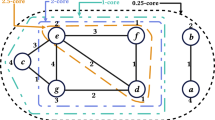Abstract
We introduce a new generic propagation mechanism for constraint programming. A first advantage of our pruning technique stems from the fact that it can be applied on various global constraints. In this work we describe a filtering scheme for such a family based on Dulmage-Mendelsohn Structure Theorem. Our method checks the feasibility in polynomial time and then ensures hyper-arc consistency in linear time. It is also applicable to any soft version of global constraint expressed in terms of a maximum matching in a bipartite graph and remains of linear complexity.
Similar content being viewed by others
References
Alt, H., Blum, N., Mehlhorn, K., & Paul, M. (1991). Computing a maximum cardinality matching in a bipartite graph in time \(O(n^{1.5} \sqrt {m / \log n})\). Information Processing Letters, 37, 237–240.
Beldiceanu, N., Carlsson, M., & Rampon, J.-X. (2006). Global constraint catalog. Technical Report T2005-08, Swedish Institute of Computer Science, 15 Sept 2006.
Beldiceanu, N., Katriel, I., & Thiel, S. (2004). Filtering algorithms for the SAME constraint. Lecture Notes in Computer Science, 3011, 65–79.
Berge, C. (1957). Two theorems in graph theory. Proceedings of the National Academy of Sciences of the United States of America, 43, 842–844.
Cormen, T.H., Leiserson, C.E., Rivest, R.L., & Stein, C. (2001). Introduction to algorithms (2nd ed.). Cambridge, MA: MIT Press/McGraw-Hill.
Dulmage, A.L., & Mendelsohn, N.S. (1958). Coverings of bipartite graphs. Canadian Journal of Mathematics, 10, 517–534.
Gabow, H.N., & Tarjan, R.E. (1985). A linear-time algorithm for a special case of disjoint set union. Journal of Computer and System Sciences, 30, 209–221.
Hall, P. (1935). On representatives of subsets. Journal of the London Mathematical Society, 10, 26–30.
Hell, P., & Kirkpatrick, D. G. (1993). Algorithms for degree constrained graph factors of minimum deficiency. Journal of Algorithms, 14, 115–138.
Hopcroft, J. E., & Karp, R. M. (1973). An O(n 5/2) algorithm for maximum matchings in bipartite graphs. SIAM Journal on Computing, 2(4), 225–231.
Kocjan, W., & Kreuger, P. (2004). Filtering methods for symmetric cardinality constraint. Lecture Notes in Computer Science, 3011, 200–208.
König, D. (1916). Über Graphen und ihre Anwendung auf Determinantentheorie und Mengenlehre. Mathematische Annalen, 77, 453–465.
Lovász, L., & Plummer, M. D. (1986). Matching theory. Annals of discrete mathematics (29). North-Holland, Amsterdam.
Norman, R. Z., & Rabin, M. O. (1959). An algorithm for a minimum cover of a graph. Proceedings of the American Mathematics Society, 10, 315–319.
Older, W. J., Swinkels, G. M., & van Emden, M. H. (1995). Getting to the real problem: Experience with BNR Prolog in OR. In 3rd international conference on the Practical Application of Prolog (PAP’95) (pp. 465–478). Alinmead Software Ltd.
Petersen, J. (1891). Die Theorie der regulären Graphen. Acta Mathematica, 15, 193–220.
Petit, T., Régin, J.-C., & Bessière, C. (2001). Specific filtering algorithms for over-constrained problems. Lecture Notes in Computer Science, 2239, 451–463.
Quimper, C.-G., López-Ortiz, A., van Beek, P., & Golynski, A. (2004). Improved algorithms for the global cardinality constraint. Lecture Notes in Computer Science, 3258, 542–556.
Régin, J.-C. (1994). A filtering algorithm for constraints of difference in CSPs. In Proceedings of the 12th national conference on Artificial Intelligence (AAAI-94) (pp. 362–367).
Régin, J.-C. (1996). Generalized arc consistency for global cardinality constraint. In Proceedings of the 13th national conference on Artificial Intelligence (AAAI-96) (pp. 209–215).
Tarjan, R. E. (1972). Depth first search and linear graph algorithms. SIAM Journal on Computing, 1, 146–160.
van Hentenryck, P., & Carillon, J.-P. (1988). Generality versus specificity: An experience with AI and OR techniques. In Proceedings of the National Conference on Artificial Intelligence (AAAI) (pp. 660–664).
Zanarini, A., Milano, M., & Pesant, G. (2006). Improved algorithm for the soft global cardinality constraint. Lecture Notes in Computer Science, 3990, 288–299.
Zhou, J. (1997). A permutation-based approach for solving the job-shop problem. Constraints, 2(2), 185–213.
Author information
Authors and Affiliations
Corresponding author
Rights and permissions
About this article
Cite this article
Cymer, R. Dulmage-Mendelsohn Canonical Decomposition as a generic pruning technique. Constraints 17, 234–272 (2012). https://doi.org/10.1007/s10601-012-9120-4
Published:
Issue Date:
DOI: https://doi.org/10.1007/s10601-012-9120-4




